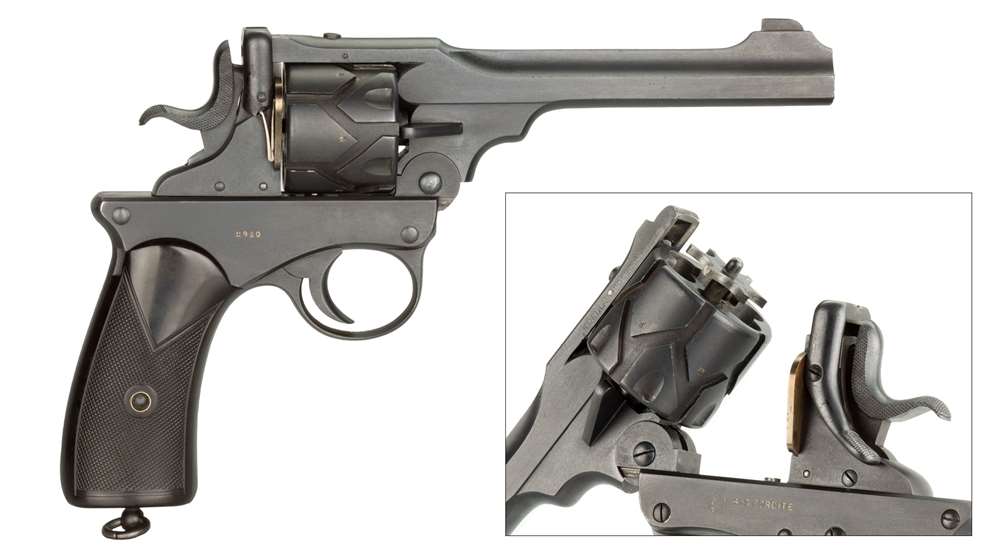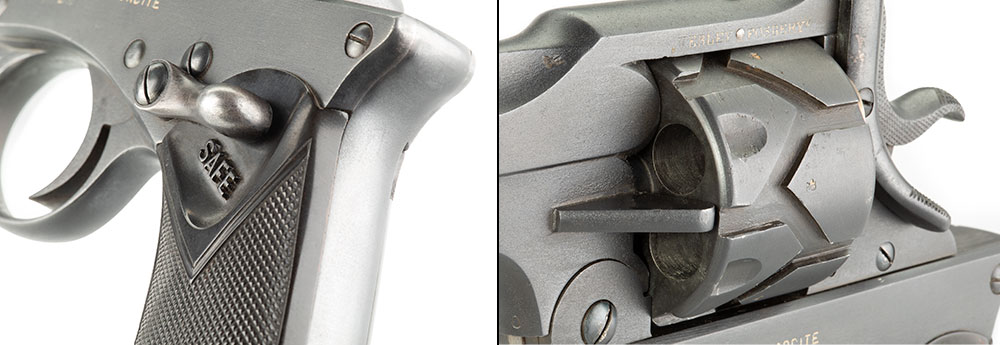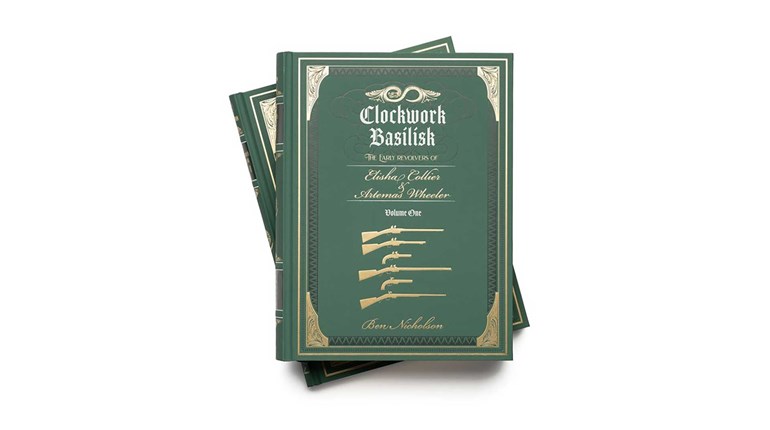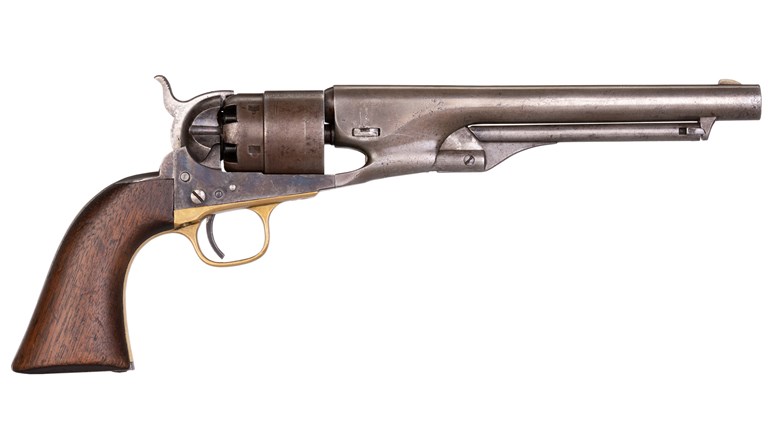
Sam Spade: What happened?
Tom Pohlhaus: Got him right through the pump with this.
[He takes a revolver from his coat pocket, holds it toward Spade but Spade doesn’t take it. After a moment, Pohlhaus flashes his light on it. Mud inlays the depressions in the revolver’s surface.]
Pohlhaus: A Webley. English, ain’t it?
[Spade takes his elbow from the fence post, leans down to look at the gun, but does not touch it.]
Spade: Yes. Webley-Fosbery Automatic Revolver, .45, eight shot. They don’t make them anymore.
Such was the screen debut of the Webley-Fosbery semi-automatic revolver in John Houston’s classic “The Maltese Falcon,” based on Dashiell Hammett’s 1930 novel by the same name. Both the source novel and the movie reference the Fosbery by name, but most readers and moviegoers had likely never seen this curious British revolver. Production had ceased in 1924, with fewer than 5,000 of them made. And yes, you read that right, a semi-automatic revolver. As our dear friend Garry James once said, it was the answer to a question that no one ever asked.
P. Webley & Son of Birmingham, England, had produced revolvers for the British military since 1853, and since 1887 the company produced the standard sidearm of the British Army. Merging with W. & C. Scott in 1897, it became known as Webley & Scott, the name it retains to this day. Of the dozens of handgun models W. & C. Scott has manufactured in the past 170 years, none are as interesting or as revolutionary as the one designed by Brigadier George Vincent Fosbery, VC, in 1895. The Webley-Fosbery was patented and introduced in 1901. What made it unique then, as it is now, is that it is a revolver that is semi-automatic. That is to say, the firing of the revolver rotates the cylinder and cocks the hammer automatically after every shot is fired, rather than pulling the trigger.
Fosbery’s design was perhaps trying to solve the age-old debate between American and British revolver makers as to which system was more accurate or practical. Samuel Colt rabidly defended his single-action revolver patents by claiming that only a fully cocked gun would deliver an accurate shot. British makers like Robert Adams and John Deane challenged Colt’s market share by introducing double-action revolvers, which they marketed as able to deliver six shots faster than the Colt. It was a contest between accuracy and speed. Fosbery’s semi-automatic revolver offered a single-action trigger pull that was theorized to be a combination of the best of both worlds.

Fosbery designed a revolver with a six-shot cylinder that literally cut the frame of the revolver in half horizontally and placed a stationary stud in the lower frame that fit into a grooved zig-zag-like channel cut into the cylinder. The force of the recoil from the first round would cause the top half of the frame to recoil rearward, rotate the cylinder half a turn and cock the hammer. A large mainspring would force the top part of the frame forward following the initial recoil and rotate the cylinder the other half turn. The gun was now cocked, and a new round was in battery to be fired immediately. The innovation was that all it would take to fire the next round was a few ounces of pressure on the trigger to release the hammer and fire the gun once again. No longer would a shooter have to manually cock the revolver, nor would they have to place undue pressure on the trigger to work the action of cocking the hammer and rotating the cylinder manually.
Webley produced two models of the Webley-Fosbery in the standard British .455 Eley military cartridge, the Model of 1901 and Model of 1903. The gun Hammett referenced was the Model of 1902, an eight-shot cylinder in .38/200 caliber. Only 300 or so of the Model 1902 are known to exist.
The Webley-Fosbery was tested by the U.S. Army Ordnance Department in 1902 and again in 1907 to replace the standard service sidearm then currently in use by the U.S. Cavalry. Although it performed well in loading and accuracy tests as well as stopping power, the high tolerance of the slide and recoil mechanism did not fare well under the dust and dirt phase of the competition, and the Webley-Fosbery lost out to John Browning’s semi-automatic that became the fabled Colt Model 1911.
As if the appearance of the Webley-Fosbery in “The Maltese Falcon” wasn’t obscure enough, the revolver also received rave reviews in the writings of Walter Winans, who won Olympic gold at the 1908 London games and silver at the 1912 Stockholm games (where George S. Patton, Jr. narrowly lost gold in the Pentathlon). Winans was a devoted advocate of the revolver that didn’t take significant pressure to fire and reload. He once demonstrated his prowess with the revolver by shooting 12 shots, using a Prideaux speedloader, into a 3-inch bullseye at 12 yards at speed.
The British Army never formally adopted the revolver, but hundreds were privately purchased by British officers and used during the last stages of the Boer War and World War I. Pilots of the Royal Flying Corps appreciated the fact that the firearm did not eject spent shells when fired, allaying a fear that some had that a hot shell casing from a semi-automatic might land on and ignite the heavily doped fabric of their flying machines.
And, as for Bogart’s line in the first film noir, he had it kinda-sorta right: the gun Ward Bond—as Tom Pohlhaus—held out for Bogey to inspect was actually a .455 Eley six-shot, today considered the jewel in the crown of any British-pistol collector’s inventory.






































